Journey to My First Pedalboard
28 Jul 2024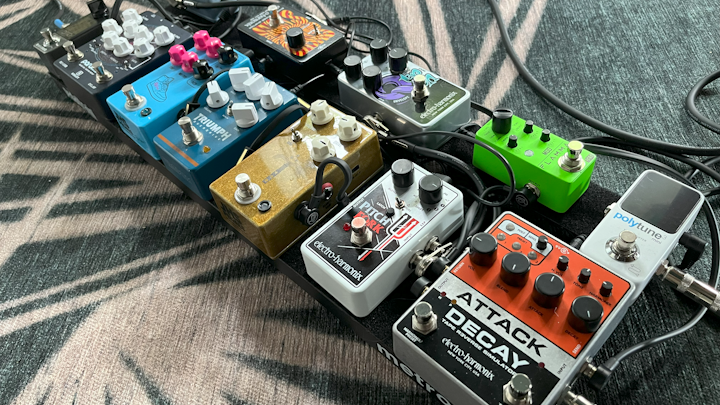 My first electric guitar was a hand-me-down from my uncle, given a few years after I started playing guitar in elementary school. It was the era of grunge, and much of the music I was listening to was filled to the brim with distortion. A stark contrast with my modest electric setup. And yet, when I assembled my own money to buy my first ever guitar pedal… I hipstered myself. I could have bought a distortion pedal like the Boss DS-1, used prominently by Nirvana and so many others. Or a Big Muff Pi fuzz pedal, used heavily by the Smashing Pumpkins. Or I even could have bought a delay pedal to do my best impression of U2’s The Edge. But no… I decided at the last minute to get something quirky and “unique”: an octave pedal, the DOD Octoplus. It was immediately clear I had made a mistake. An octave pedal can have its uses, but as a first and only pedal? A dismal choice. And I had no money for a second pedal.
My first electric guitar was a hand-me-down from my uncle, given a few years after I started playing guitar in elementary school. It was the era of grunge, and much of the music I was listening to was filled to the brim with distortion. A stark contrast with my modest electric setup. And yet, when I assembled my own money to buy my first ever guitar pedal… I hipstered myself. I could have bought a distortion pedal like the Boss DS-1, used prominently by Nirvana and so many others. Or a Big Muff Pi fuzz pedal, used heavily by the Smashing Pumpkins. Or I even could have bought a delay pedal to do my best impression of U2’s The Edge. But no… I decided at the last minute to get something quirky and “unique”: an octave pedal, the DOD Octoplus. It was immediately clear I had made a mistake. An octave pedal can have its uses, but as a first and only pedal? A dismal choice. And I had no money for a second pedal.
The end result? I spent the next 25 years primarily only playing acoustic guitar.
It wasn’t until I was 40 years old that I actually bought myself my very own electric guitar (a Fender Stratocaster, classic and versatile). It only took a global pandemic to push me to make the purchase, stuck inside with an evaporated social calendar. But I was ready to do it right, and get pedals too. I did a lot more research this time (thanks dramatically more developed internet!). So without spending too much money I got some classic building blocks.
- Overdrive: MXR Classic Overdrive
- Fuzz: EHX Big Muff Pi Nano
- Phaser: EHX Small Stone Nano
- Delay: MXR Carbon Copy
It was enough to let me fool around and enjoy myself. But in time, life started to normalize. I couldn’t continue to leave this awkwardly daisy-chained cluster of pedals and wires out on the floor. They got shuffled away, to come out sporadically. Inconvenient set-up and clean-up prevented this from being a regular practice.

Years later, I moved into a bigger house. Literally the first things I moved over were my instruments. After breaking it in with my acoustic guitar, I realized I could set up my electric guitar, amp, and pedals in this new space. The moving boxes hadn’t yet arrived, but I filled that empty house with some epic fuzz. For a moment, it was glorious. But the pedals were still a mess of tangled wires, so I moved everything into the basement. Sadly out of sight, out of mind, and underloved.
After over a year of being in the new house, with the financial pressure reduced, I felt like I could explore solutions to this problem. I had long ago learned that an instrument in a case never gets played but an instrument on a stand does. You have to remove the friction between you and the behavior you want. An effects-free electric guitar is okay, but never is going to be a draw over my acoustic. However, an electric guitar connected with all sorts of toys is a totally different story. So I needed a way to organize the toys.
Enter the pedalboard.
I was aware of the concept of a pedalboard, but having no experience I turned to YouTube. I sampled a few tutorial videos, but the one that got me there was this one from JHS. Not only did it walk me through everything I needed to build my pedalboard, but it also sent me down a rabbit hole of an incredibly entertaining and well-produced channel all about pedals. It was not a cheap discovery.
Knowledge in hand, I waltzed into Guitar Center to pick up the board (a Pedaltrain Metro 24), the power supply (Voodoo Lab Pedal Power X8), and some patch cables. And while I was there… I grabbed a pair of used pedals to round out my options:
- Distortion: Boss DS-1
- Reverb: EHX Holy Grail
For some reason the sales associate tried to talk me out of buying any TC Electronic pedals. Which is funny, because their looper would become the single most effective tool in getting me to play my guitar. More on that later. So the internet provided 2 more pedals to round out the rig:
- Looper: TC Electronic Ditto+
- Tuner: TC Electronic Polytune3
Time for assembly.
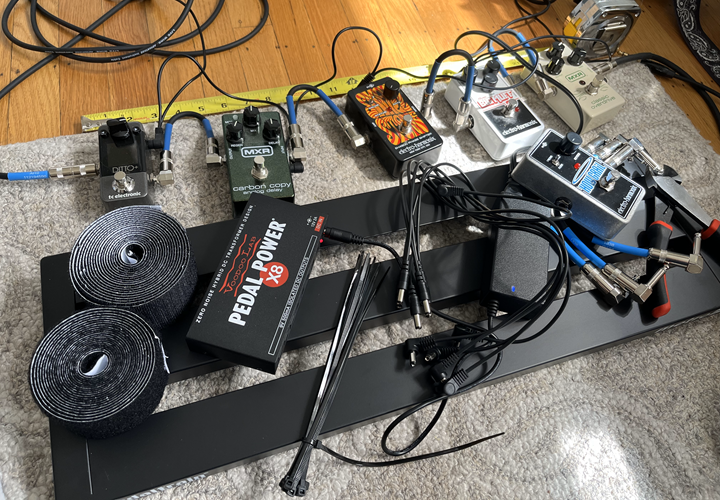
Imagine a time lapse here of lots of velcro, threading power cables through the board, and maneuvering stiff patch cables. But I emerged victorious.
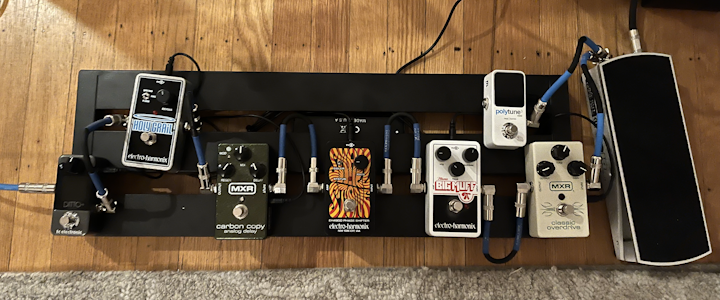
But most importantly, it solved my problem by enabling everything to be put neatly away at a moment’s notice. Immediately I started playing a lot more. I had my looper pedal to give me a way to layer my creativity. I had fun noise machines at my feet. Mission accomplished.
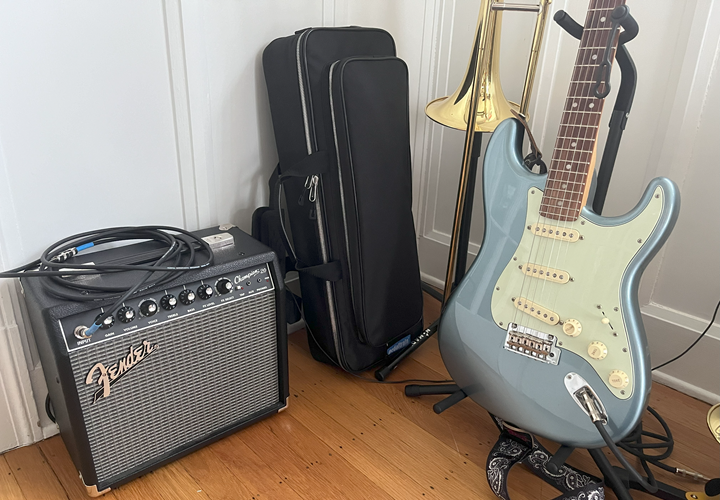
But Pandora’s box had been opened. I had created a platform for experimentation, and introduced to myself to a whole field of guitar effects to lust after. What followed was a period of rapid experimentation and expansion fueled by the combination of The JHS Show and reverb.com.
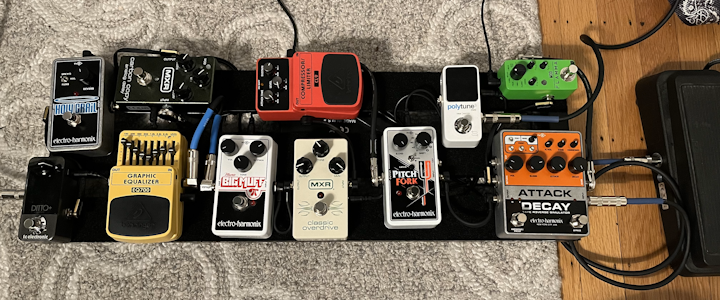
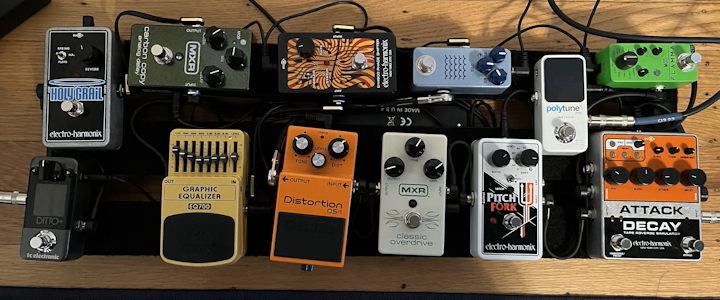

I was going to need a bigger board…